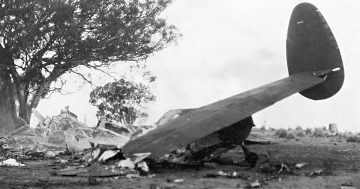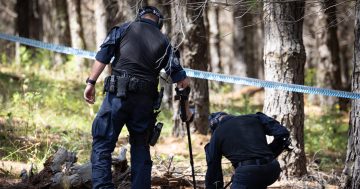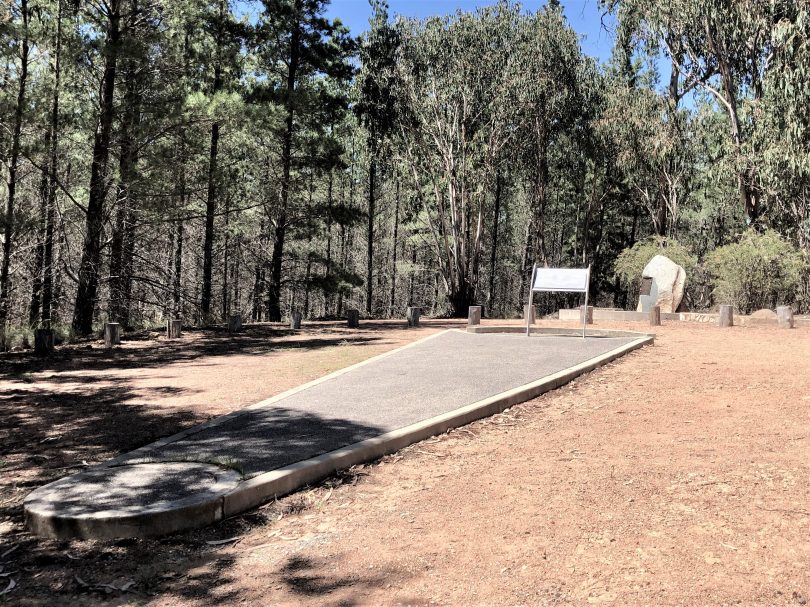
The Air Disaster Memorial at Fairbairn Pine Forest, where a RAAF plane full of government officials crashed in 1940. Photo: James Coleman.
It’s 10:00 pm one night in the year 2000, and Casie and her three friends have pulled into a small clearing in a dense pine forest. They’re here to see what all the fuss is about.
“We parked up, leaving the car running with the lights on,” she says.
“After sitting there for a couple of minutes, the engine just stopped. At first, we didn’t think anything of it. The lights were still on, and I had a torch in the back of the car, so we opened the bonnet to see if we could work out what had happened.
“It was quiet at first, then all of a sudden we heard what sounded like a few girls screaming and crying. At this point, we all freaked out and jumped back in the car, desperately trying to start it. This went on for about 10 minutes. Eventually, the car started and we left. I have never been back since. We never actually saw anything, but I’ll never forget the sounds of the screaming and crying.”
Casie and her friends aren’t alone – in more ways than one, it seems.
The Air Disaster Memorial is a large granite monolith and plaque halfway up a gentle hill in Fairbairn Pine Forest, about 1.5 km from Pialligo Avenue. A large ‘traffic island’ in the shape of an aeroplane wing and another plaque were added later.
Access used to be via a dirt road, which crossed over a cattle grid and lead straight up, but given this now forms part of a ‘dangerous’ military testing site, walking from the paintball entrance is the only way in today.
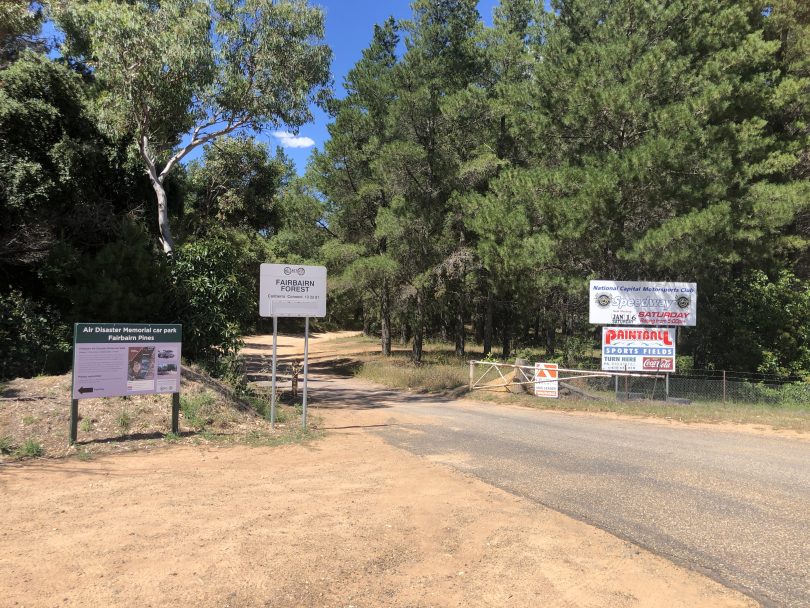
The entrance to the Fairbairn Pine Forest from Pialligo Avenue (the gate is shut every day at 6:00 pm). Photo: James Coleman.
I’m here at 3:00 pm on a Sunday, ostensibly because there’s natural light for photos. But visiting at night has become somewhat of a dare among locals.
Since the 1970s, reports abound of mysterious noises and figures, but also things happening to cars – stalling, failing to start, radios flicking on and off, lights going out, and moving while in ‘park’ with the handbrake on.
Sceptics might dismiss ‘ghost stories’ as nothing more than overexposure to alcohol or otherwise, but there is something objective about your car suddenly deciding not to work properly.
Like every ghost story ever, these originate from a scene of grisly deaths.
On 13 August 1940, three Commonwealth ministers and the Chief of the General staff were flying in from Melbourne. This was in the thick of World War II and they would be meeting with Prime Minister Robert Menzies to think tank Australia’s efforts.
On the approach to Canberra Airport, however, the RAAF Lockheed Hudson stalled and smashed into the hillside. If the impact didn’t instantly kill everyone on board, the subsequent flames did.
Given the who and the when, it became a national disaster with no shortage of conspiracy theories.
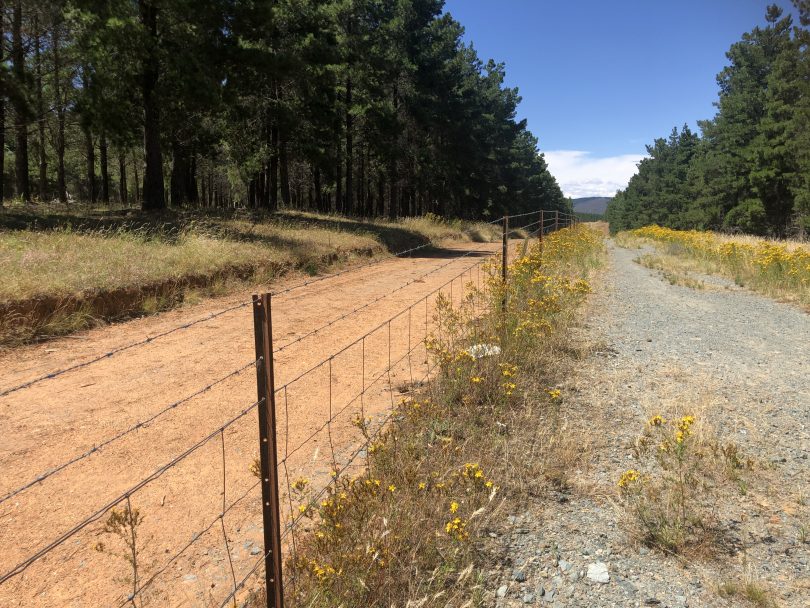
It is quite hard to get lost in Fairbairn Pine Forest. Photo: James Coleman.
Thirty years later, in May of 1971, a walker stumbled upon the remains of a young girl.
Twenty-year-old Keren Rowland had been murdered 15 metres from the track three months prior. It remains a cold case. Police recently picked it up again in December last year.
A quick poll of the Queanbeyan Community Notice Board on Facebook reveals that about 25 per cent of respondents have experienced something chilling involving them or their car while visiting the memorial.

You get the idea – it’s not terribly safe around the military testing zone. Photo: James Coleman.
Tim the Yowie Man has led ghost tours to the Air Disaster Memorial for 20 years and says that through the 1970s to 1990s, many young drivers would head there as a sort of maiden voyage on getting their licence.
“As a result, the cars were those of 18 to 22-years-olds who usually could only afford pretty poor quality or old cars,” he says.
“To what extent it was a case of the car’s malfunctioning… needs to be considered.”
Tim, or TYM as he’s often called, recounts his own experience.
“One time we were all out of the bus at the memorial when suddenly the lights on the inside of the bus flashed. My colleague, Tinny, said, ‘Good one, John!’ But John the driver said, ‘I’m over here!’ He was behind us, the bus was empty.”
I think I’ve got all my photos now.
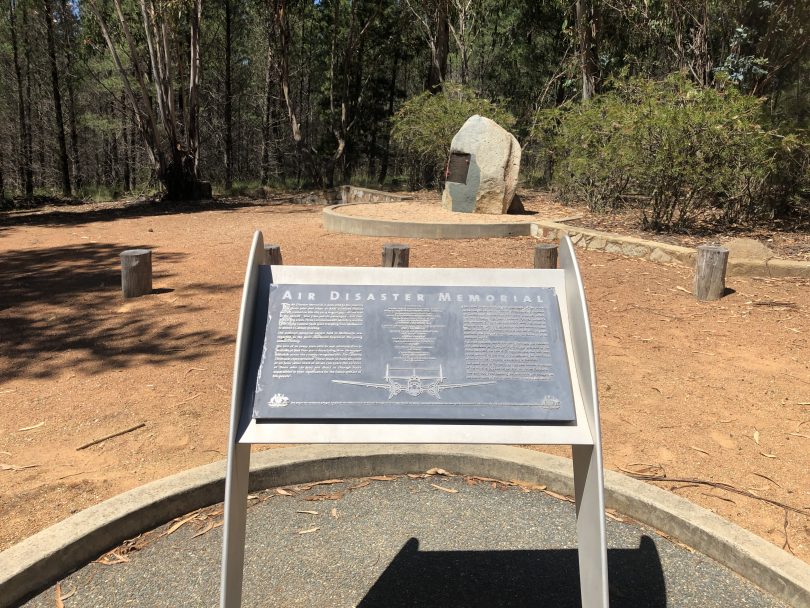
The Air Disaster Memorial plaque spells out the names of the 10 men who lost their lives here. Photo: James Coleman.












